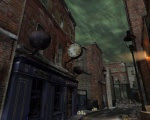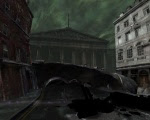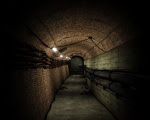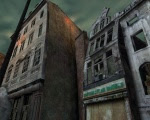London, as it was, is no more. Now, the once great city lies in ruins. A massive, sinister gash in the fabric of our reality swirls and churns, dominating the horizon as it blends into a permanently darkened sky. The Invasion, the unspeakable cataclysm that befell London, eventually engulfed humanity. This capitol of a once powerful nation has been eradicated, and The Burn – the transformation of our world into theirs – has begun.
Bloomsbury
Bloomsbury is an area of central London, in the borough of Camden. The area contains some of London's finest parks and buildings, and is particularly known for its formal squares. These include the large and orderly Russel Square, the smaller unusual round Bedford Square, Bloomsbury Square dominated by the grand Victoria House, Queen Square home to many hospitals, and Gordon Woburn and Torrington Squares, which are home to parts of University College.
The Bloomsbury district was once served by numerous tube routes, but today is only accessible via the Picadilly and Central lines. Holborn Station is the closest secured site to this area, although recent changes due to The Burn may have unearthed a secret tunnel that is part of the disused British Museum tube station.
Bloomsbury
Bloomsbury is an area of central London, in the borough of Camden. The area contains some of London's finest parks and buildings, and is particularly known for its formal squares. These include the large and orderly Russel Square, the smaller unusual round Bedford Square, Bloomsbury Square dominated by the grand Victoria House, Queen Square home to many hospitals, and Gordon Woburn and Torrington Squares, which are home to parts of University College.
The Bloomsbury district was once served by numerous tube routes, but today is only accessible via the Picadilly and Central lines. Holborn Station is the closest secured site to this area, although recent changes due to The Burn may have unearthed a secret tunnel that is part of the disused British Museum tube station.
Covent Garden Market
The Covent Garden Market district is a typical example of the devastation that was wrought during the demonic invasion. Buildings are in various states of disrepair, fires of infernal origin still burn under a perpetually darkened sky, and creatures of the underworld lurk the abandoned streets. There are few places to hide or find cover, and any unarmed adventurer has an extremely short life expectancy above ground. Shattered windows, desolate store fronts and hastily erected defenses can be seen in the eerie avenues, as well as evidence of the hard-fought battles that seemed to rage everywhere in the once proud city of London.
The British Museum
The oldest museum in the world, The British Museum was established in 1753 and was based largely on the collections of the noted physician, scientist and collector Sir Hans Sloane. His work in the field of botany, and especially his study of chemistry at the Apothecaries Hall in London, laid the groundwork for what would be the core the early museum’s collection.
The British Museum is home to over seven million objects from all continents illustrating and documenting the story of human culture from its beginning to the present. Many of the artifacts are stored underneath the museum due to lack of space. Though it principally became a museum of cultural art objects and antiquities, the British Museum was founded as a 'universal museum'.
After its foundation the British Museum received several gifts, including ancient relics and antiquities. From Roman and Greek artifacts to an extensive collection of Egyptian sculptures. Amongst its more notable acquisitions were the Rosetta Stone and the infamous Elgin Marbles.
The Queen Elizabeth II Great Court is a covered square at the centre of the British Museum designed by the architects Foster and Partners. The roof is a glass and steel construction with 1,656 pairs of uniquely shaped glass panes.
The British Museum is home to over seven million objects from all continents illustrating and documenting the story of human culture from its beginning to the present. Many of the artifacts are stored underneath the museum due to lack of space. Though it principally became a museum of cultural art objects and antiquities, the British Museum was founded as a 'universal museum'.
After its foundation the British Museum received several gifts, including ancient relics and antiquities. From Roman and Greek artifacts to an extensive collection of Egyptian sculptures. Amongst its more notable acquisitions were the Rosetta Stone and the infamous Elgin Marbles.
The Queen Elizabeth II Great Court is a covered square at the centre of the British Museum designed by the architects Foster and Partners. The roof is a glass and steel construction with 1,656 pairs of uniquely shaped glass panes.









No comments:
Post a Comment